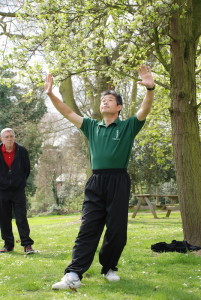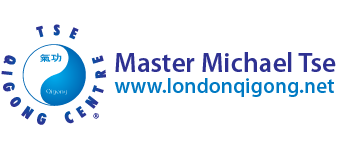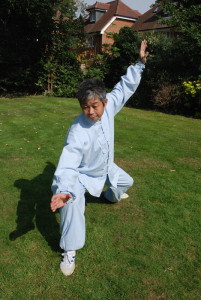What Will I Learn in the Qigong Classes?
Balancing Gong
 First you will begin with Balancing Gong which is a beginning set of exercises which Michael Tse developed in 1993 when he was teaching in Yorkshire, England. He saw that, in the beginning, not everyone could manage the more challenging movements of Wild Goose Qigong, particularly if they had any injuries or illness.
First you will begin with Balancing Gong which is a beginning set of exercises which Michael Tse developed in 1993 when he was teaching in Yorkshire, England. He saw that, in the beginning, not everyone could manage the more challenging movements of Wild Goose Qigong, particularly if they had any injuries or illness.
So he created Balancing Gong based upon on the principles of Wild Goose Qigong which are:- relaxation, posture and natural breathing. In order to do the movements correctly, we need to have the right posture and relaxation so that Qi can flow unrestricted through the body.
Balancing Gong is also very good for helping:
-
Back pain and joint problems or injuries
-
Insomnia
-
Posture
-
Reduce stress
There is a Balancing Gong DVD and a Balancing Gong Book to aid you in your practice at home.
Healthy Living Gong
Next, you will move onto a set of movements called Healthy Living Gong. Michael Tse created these movements in 1995. In his healing practise, he found that certain kinds of movements could stimulate the healing responses in the body and so he began to develop individual movements for healing particular parts of the body or illnesses.
Healthy Living Gong Part I works for relaxation and balance in the body. Healthy Living Gong Part II works for fitness and coordination. Healthy Living Gong Part III works for strength and power. The third set of Healthy Living Gong is very interesting as many of the movements are based upon martial art principles. Like Balancing Gong, Healthy Living Gong does not take too much space to practise and individual movements can be repeated again and again to help with a specific problem.
Regular practise can help improve:
- Coordination and help prevent strokes
- Sleeping, concentration and memory
- Bone density
- Chronic tiredness
Healthy Living Gong Part I, II and III are available on DVD and in book form which make it convenient for students who are unable to attend regular classes to practise at home.
Wild Goose Qigong
 After completing and reaching a good standard of their Balancing Gong and Healthy Living Gong, students are then ready to begin Wild Goose Qigong. There are two levels of Wild Goose Qigong.
After completing and reaching a good standard of their Balancing Gong and Healthy Living Gong, students are then ready to begin Wild Goose Qigong. There are two levels of Wild Goose Qigong.
Wild Goose 1st 64
The first 64 movements work for post-natal problems and illnesses using larger movements, fluttering and sweeping. Post-natal problems are all the kinds of problems that happen after we are born and can be things like injuries, cancer, chronic fatique (ME), etc.
Wild Goose 2nd 64
By contrast, the second 64 movements are more subtle and work deeper internally on pre-natal problems. Pre-natal problems are body weaknesses that are passed down to us from our family. These may be things like hereditary heart disease, diabetes, etc. These problems take much longer to help and so the 2nd 64 form is almost twice as long as the 1st 64.
Other Kunlun Dayan Qigong Forms
Each of the forms within the Kunlun Dayan System have their own emphasis and special meanings. For instance, when we talk about seven stars this refers to the Big Dipper, which is often used in connection with our practice. The Big Dipper relates to the North Star and the kidneys.
Other Qigong forms like Plum Blossom Gong are for developing our Sky Eye and spiritual potential. Jade Pillar Gong is good for the back and spine and can help make the body more flexible. Swimming Dragon Gong is good for the kidneys and uses a lot of circular movements and one legged stances to create very strong bone Qi.
Michael Tse says, “For myself, the Kunlun system is one of the most profound systems of Qigong that I have ever seen. It covers Yin and Yang, soft and hard. Some forms with a more martial aspect like Dayan Palm, Dayan Fist and the weapon forms are Yang, while forms like Wild Goose Qigong are more Yin. There are also many different kinds of meditation to create either soft or strong Qi in the body.”

